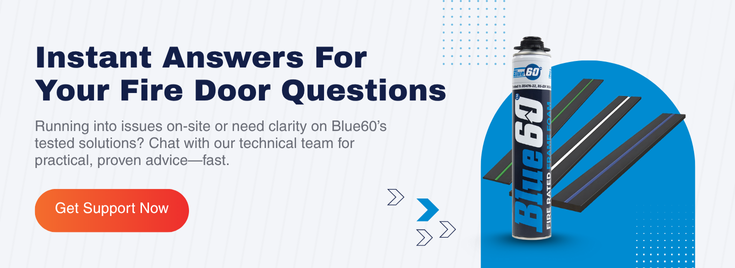The Best Products For Installing A Fire Door
Fire doors and the fixtures and fittings that surround them are vital for maintaining building compartmentalisation, ensuring safe evacuation routes, and limiting property damage. Correctly selecting and installing every element of a fire door, from door leaf to seals and fixings, will ensure the finished installation is safe, secure and meets the required standards.
Considerations
When selecting fire door products, it’s essential that you stick to items that adhere to building regulations, such as Approved Document B, in the UK. All fire doors have specific fire-resistance ratings (e.g., FD30 and FD60). This indicates their fire resistance duration. If other materials are used, such as solid timber, composite or steel, they must be fire-rated and tested, if they’re going to contribute to the assembly's overall fire resistance.
Types Of Fire Doors
Fire doors come in various types and with different fire-resistance levels. Commonly, solid core doors are used due to their robust construction and greater inherent fire resistance compared to hollow core doors.
Composite fire doors combine multiple materials in order to balance durability, aesthetics and fire resistance to achieve the required fire rating performance. Fire-resistant glass doors are also available. These feature specialist glazing that’s designed to maintain its integrity during a fire.
Installation Process
Before installing a fire door, it’s crucial that a pre-installation assessment takes place. This should involve inspecting the door frame for structural soundness and squareness. Accurate measurements should then be taken to ensure specific gaps are left at the sides, top and bottom of the door (2 - 4 mm at the top and on the sides, a maximum of 8mm at the bottom or if BS EN 1634 - 3 Smoke Control is required, then the gap at the bottom should not be larger than 3 mm). These gaps are then filled using fire-rated expanding foam, intumescent strips and smoke seals.
Fire-rated hinges and hardware should always be used to ensure the door is up to standard and safe to use. Tools and equipment needed for fire door installations include tape measures, levels, power drills, screwdrivers, fire-rated fixings, intumescent strips, smoke seals and fire-rated foam like Blue60.
All components, including the frame, hinges, seals and any fire door foam used, must be compatible and installed according to specific manufacturer guidelines. Using non-fire-rated materials or incorrect fixings could compromise the fire resistance of the door and put the building and its occupants at risk.
Maintenance And Safety
Regular inspections are essential to ensure fire doors remain effective. This includes checking for damage to the door leaf, frame, hinges and seals. What’s more, doors should close securely, without obstruction, intumescent and smoke seals should be intact and self-closing devices should be in good working order. Any issues that are uncovered during an inspection should be addressed as soon as possible.
To learn more about fire-rated foam, fire doors and proper installation, contact us and speak to a member of our team today.
Image Source: Canva
Subscribe by email
You May Also Like
These Related Stories

How To Install A Fire Door: Essential Tips For Specifiers

Are Fire-Rated Packers Required When Using Blue60 Fire Foam?



No Comments Yet
Let us know what you think